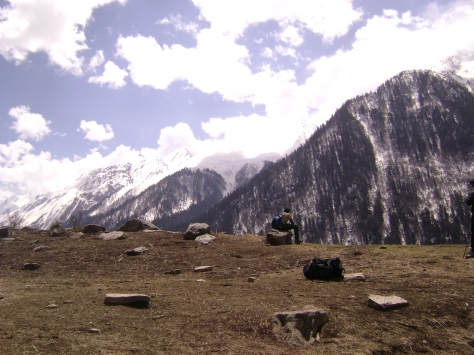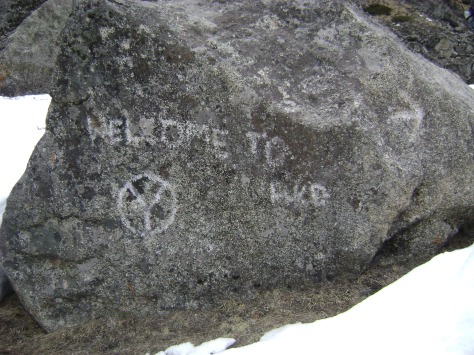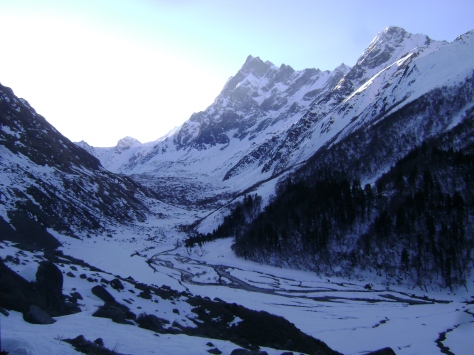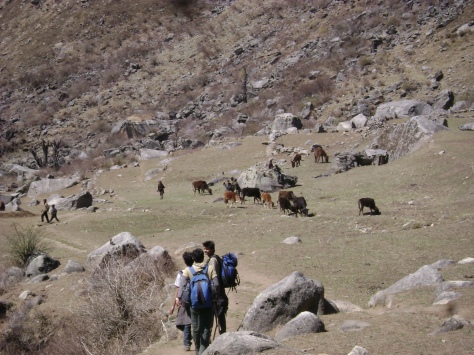It all began on 22nd of March last year, when for some of us, the idea of going on a trek pipped the thought of celebrating Holi back home. What follows is an account of our journey to Har-ki-Dun, some of which was recorded during the trip itself while portions of it have been added later and lazily enough. While the most convenient time for visiting Har-ki-Dun is between May to August, an off-season trek has its own share of hardships and experience. Here is how the story goes:
Day 0:
Settled within the lower reaches of Garhwal is a peaceful hamlet. A small place – it ends just as abruptly as it begins, the residences fade away into the greens almost as silently as the little town itself. The remnants of a tarmac gradually disappear into a dirt track as the houses are replaced by tall conifers. In the distance, the snow beckons, through chilly weather, rough undulating terrains and water that is insanely cold. The voices of this town’s inhabitants, the tinker of the horses’ bells, the occasional crow of a rooster – all seem as natural as the twitter of the birds nestled high up on the pine trees or the rushing water in the foothills below.
This is Sankri – our first stop after endless hours of bus travel that started from Dehradun: over eight hours of journey through dusty plains, green hills, and over roads precariously narrow and fractured by the recurrent earthquakes. People here are simple, their lives slow but resolute; much like the mountains they dwell in.
Day 1:
We head for Taluka, 11 km. from Sankri – this is where the trek starts-off. As we wait for the jeep’s departure from Sankri, the hours slowly trickle by. The inactivity propels most to contemplate a foot trek from Sankri itself. Thankfully, good sense prevails. It’s not as much the road or the distance but the fact that another stretch of 14 km. awaits us after it that we stick to the jeep.
The road we traveled was, well, hardly a road. It went in all directions and often quite suddenly. And from the luggage rack mounted on top which some of us chose to ride on, the threadbare routes seemed more hostile and the sheer drop off the edges a lot scarier. It was a matter of choosing visual delight over physical comfort as our rears took quite a beating. The unparalleled panoramic view, though, more than made up for everything. As viewed from atop the jeep, the rugged mountain slopes dwarfed all imagination; a sense of some giant hands molding and carving those great Himalayas settled so strongly within me. Titans, if ever they ruled the Earth, must have envisioned something to this effect – the earth rearing to meet the heavens. It took us 45 min. to cover that distance, as the jeep rumbled on, carefully negotiating every precarious turn and drop.
From Taluka, we embark on our first leg of the trek up to Osla-Seema. Osla is a village up on the hills where most folks dwell, and at the base of the hills opposite to it is a cluster of small, rundown huts: Seema. Between the two flows the river Tons – the largest tributary of the Yamuna. There is an interesting legend about this river: The local inhabitants claim to be the descendants of Kauravas. The Duryodhana Temple in the village of Osla is a tangible proof of this belief. Folks say that the Tons, anciently known as Tamas, is formed by the tears of the local people who wept over the defeat of Kauravas in the epic battle of Mahabharatha. The river water is not used for drinking, as according to the belief, the tears still flow.
For most parts of our trek from Taluka, our path ran parallel to the river. Occasionally, the trail departed from the river to take us through dense forests. Here lay the most trying stretch of this leg as the path would rise and fall steeply and all too often. We had the company of a local who was on his way to his village Gangar, just 4 km. before Seema. Consequently, the first 10 km. were covered much faster than we had thought possible. The kind fellow gave us sufficient rests in between but quite obviously that wasn’t as much as we had hoped for. An occasional replenishment through Glucose powder and biscuits and water filled from the clean streams of Himalayas saw us through, as we covered the route up to Gangar in slightly more than three hours. The last 4 km. was a different story altogether. We were on our own, with our energy levels and patience both wearing thin. As a result, after much coaxing and resting and coaxing we covered the final stretch for the day in around two hours.
The stay in the GMVN guesthouse at Seema was alright and the food simple. A small, closed shack served as our kitchen/dining room for the night. The cooking fire provided the necessary heat and way too much smoke. Our eyes smarting and gasping through the suffocation, we downed our meals. We ate more out of necessity as we were going to need every bit of it on the final leg of our journey. The halt though was hardly as cheerful as Sankri.
Day 2:
In the morning we were greeted by a young local who wanted to know if we would like a guide. Since to the extent of our knowledge, one of the rest-houses’ caretaker was supposed to accompany us, we politely declined the offer. There was some confusion about which rest-house to lodge in. We were told that the caretaker will meet us on the bridge further ahead on our path and in the circumstance that we didn’t find them there, to continue walking as they would be sure to catch up with us on our way. From this confusion arose, probably the gravest consequences that almost jeopardized the success of our trek, yet in hindsight, feels like the most interesting thing that could have happened.
We had around 12 km. to cover and although we planned to start earlier, it was nearly 10 a.m. when we did actually make a move. As we made up our way to the bridge, after a breakfast which was hardly better than the previous night’s dinner, the arduous climb leached out much of our morning vigor. At the bridge there was no sign of either of the guides, and following the reassurances given below we continued on the beaten-down track. The balmy morning did all it could to keep our spirits up, and the pastures spread over the slopes with the grazers and the herdsmen made up for a beautiful sight. Over on the other side, giant snow covered peaks stood in stark contrast. We walked fairly fast and from the timely exchanges with the trekkers who crossed our path, managed to stay on the right track.
The first signs of snow were scarce and sparse and a couple of days old at the least. Although soon there was enough crushed snow; hardened into a slippery, icy layer that made walking up the slope a risky affair indeed. As soon as we crossed this first real impediment, the most frustrating thing happened: we lost our way. We scrambled up and down the slopes and through thorny shrubs all to find anything that would remotely resemble a way forward. Although it was only an hour past noon, the sun was long gone behind dark, ominous clouds – a forecast of the cold evening that was in store for us. This posed a grave question – whether to continue looking for a way ahead or turn back? For without any camping gear a night out in the snow wouldn’t have been too conducive to our healths. We chose to look around for a little longer. And so after losing a good hour or two we arrived on the path that was there all along, hidden away in the shrubs.
The journey here forth was mostly a matter of sticking to the path but the growing delay made us wonder if choosing to go ahead had been the right thing to do. And so followed the most testing times for us. Clueless and confused, we sorely missed the guide. Snow, now seemed more of a nuisance to our progress, and we dearly hoped the path we trudged along wouldn’t lead us astray. The occasional footprints on the dirt did much to assure us and three hours later we caught a most welcome sight. Right in front of us, on a huge boulder were chalked the words: Welcome to HKD. Oh the relief!
A couple of shacks that served as GMVN and Forest Department guesthouses were all there was to that desolation. But the sight really did cheer us up and we chose to munch onto some snacks while we waited for the trailing members to arrive. Whatever little hopes we had of meeting the guide here were summarily disposed off. Blanketed in snow and eerily silent, the place had us miles from any civilization. Standing there, watching the sun set, it felt like a different world altogether.
So here at the end of all things we stood at our destination – with no fire or shelter as dusk fast enveloped the surroundings making the desolation absolute. Thus began a spate of break-ins and trespasses as we tried to salvage the necessities from the vacant guesthouse. One of the doors had to be smashed open in order to gain access to the beds. Outside, it had grown forbidding as the temperature dropped rapidly and the water chilled the very bones. Without any kerosene oil, the insufficiently dry wood refused to catch fire and soon we gave up on our attempts at that. This meant that our evening meal comprised of uncooked noodles and the enclosed Tastemaker™ that went straight to our mouths. And frankly, that wasn’t all that bad. It was a solemn bunch of people – all five huddled together in a single room under layers of blanket that went off to sleep that night.
Day 3:
We awoke early the next morning to capture the unspoilt view the place had to offer and to take-off before the snow started to melt. Even as the first rays of sun warmed us up, we set-off back for Osla after doing the little we could to set straight the remnants of forced entry. Early in the morning, the firm snow made for an easier walk. That and the downhill walk for most parts saw us covering our distances rapidly.
Within four hours we had returned to the twin villages. Our way ahead now had two choices – one meant retracing our way precisely back through Seema and beyond while the other offered a way through Osla which eventually descended to meet the previous route half a kilometer beyond the village.
The network coverage disappears a couple of miles before Sankri and in order to get in touch with our families, we decided to head for Osla. It was here the most unsettling events of our trip unfolded. Near the STD booth, of all people, we came across the aged caretaker of the guesthouse we had chosen to ransack for our survival in that desolate wilderness. Drunk as he was at the middle of the day, his incessant probing enlightened him to the damage our (mis-)adventures had caused. The truth of our deeds stirred him into a drunken frenzy and he went about asking for a compensation of ten thousand bucks. Needless to say our refusal to comply further pissed him off and he offered to detain us until he could send someone to verify the extent of damages caused.
His foul mouth and temper had now really started to rub against us the wrong way. We tried to make him understand the helplessness of our circumstances and how he was partially to blame for failing to turn up as promised. For all it was worth, we could have argued with a brick. Eventually though, rest of the village-folk joined our cause and tried to make him understand. They prepared us noodles from the stock we were carrying with us. Those people really helped us suffer the old man and funnily enough ensured he didn’t come running after us in his drunken stupor as we left the place after handing him four hundred bucks as damages. And to think we could have avoided the whole confrontation if only we would have taken the other route.
We hadn’t quite made up our minds when we moved from Har-ki-Dun: whether to halt at Osla or keep pushing it all the way to Taluka and maybe Sankri. The above course of events though made that choice for us and we hurried on to our next stop: Taluka. It had started to pour when we were still a few miles from Taluka and the already difficult path through the forest became near treacherous at places. We walked into the sleepy town even as the lights began to fade away. We had covered, in all, more than 26 km. that day and were still hoping to catch the jeep back to Sankri. That place felt most like home somehow. Although the ride through the rough, narrow terrain gets dangerous at dusk, we succeeded in coaxing the driver to drop us off at Sankri. The extra money was of course probably still his biggest motivation. It was a pleased albeit a little tired bunch of five people that alighted at Sankri. We feasted and rested that night, filled with a sense of accomplishment all that while. We had an early morning bus to catch – to take us to Dehradun, to take us back to the clamor of civilization.
At Har-ki-Dun, I discovered the joy of being there and back again….











really liked this post…
thank you Vishal. it’s been nice hearing from you after so long 🙂